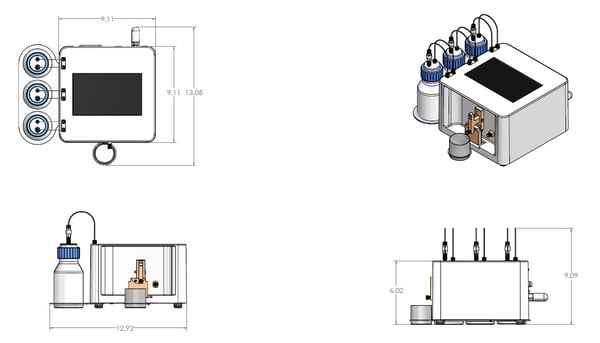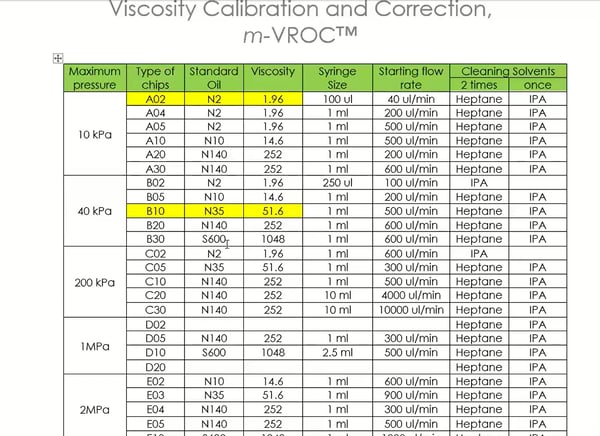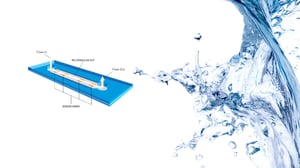VROC®(Viscometer-Rheometer-on-a-Chip) technology combines microfluidic and MEMS (Micro-Electro-Mechanical Systems) technologies to measure dynamic viscosity over a wide dynamic range of operation. The combination of microfluidics and MEMS technologies, has enabled RheoSense to redefine viscometry and develop smaller, smarter, and faster micro-liter viscometers, which can measure fluids' viscosity in a wide range of conditions. A VROC cell reads viscosity by measuring the pressure drop as a test liquid flows through its rectangular slit microfluidic channel. As the sample is forced through the flow channel, the pressure sensor array measures pressure as a function of position.
It is important to properly maintain and consistently monitor your chips to ensure optimal performance. We are sharing some simple laboratory best practices to guarantee high quality data and extend the life of your chips:
- Precautions to minimize the introduction of fibers or other large particulates to your VROC chips
- Cleaning solvent and protocol selection for your chips and samples
- Choosing and measuring NIST traceable Newtonian viscosity standards to assess the health of your chips
The channel depth for the VROC flow channel can be as small as 20 microns. A grain of sand is ~60-70 microns, making the VROC channel depth a fraction of the size of a grain of sand. This means that when proper protocols are not followed, it is easy to clog the channel with fibers or particulates that are seemingly miniscule. Here are a few tips to prevent fibers and particulates from contaminating your samples:
- Use compressed, or house, air to blow off work surfaces, vials and tools that can accumulate these fibers and particulates
- Use lint free wipes to prevent fibers of other wipes, such as Kim wipes, from contaminating your samples and clogging your chip.
- When working with the m-VROC viscometer the loading syringe tip is threaded and must be cleaned off prior to sample loading if dipped directly into your sample. To avoid any particulate contamination when cleaning the syringe tip we recommend using a syringe adaptor, which can be removed to load the syringe into the instrument.
- When working with the microVISC viscometer, pipettes are used to load samples into the instrument. Before assembling your pipettes, you should blow them off with compressed air to remove any particulates, and then assemble your pipettes on the lint free wipes to prevent contamination.
- Filtering your sample; There are different schools of thought regarding the benefits of filtering your samples, but if working with more industrial grade solvents it is ideal to utilize a syringe filter to filter out particulates from your sample for your measurements.
- When working with solutions that contain large particle aggregates, you can also centrifuge your sample to separate the large particles to the bottom of your solution, allowing you to pull off solution from the top without the large particulates.
Properly preparing your samples, chips and instruments, is only the first step in proper chip (and viscometer) maintenance. One key benefit of working with VROC technology is that you don't need to clean in between miscible samples, however you do need to clean your chips between immiscible samples and after you are done with your measurements. Properly cleaning your chips is crucial to optimizing chip performance and elongating chip life. When VROC chips are not properly cleaned residue from past samples can remain in the sample, which will affect the accuracy of viscosity measurements through your flow channel. VROC chips can be cleaned manually or by utilizing the RheoSense automated Chip Cleaning Station. Here are a few key tips to properly cleaning your chips:
- Ensure you are cleaning with a solution that is compatible with your sample. For example: when working with protein or antibody samples you typically use a buffer for the sample and then flush your chip out with that compatible buffer. When working with polymer solutions you will typically have them in an organic solvent, and can flush your chip out using that same organic solvent.
- When working with a buffer, the solution can begin to crystalize over time leaving a residue along your flow channel. To prevent this we recommend cleaning your chip with an additional cleaning solvent such as 1% Aquet to rinse out the salts from your flow channel.
- We also recommend enzymatic cleaning when working with protein solutions.
- When working with high viscosity samples, low viscosity cleaning solvents can create tunneling of the chips - leaving sample along the walls of your chips creating a "tunnel". To prevent this we recommend a step down cleaning protocol, which includes diluting cleaning solvent into your sample as an intermittent step to remove the sample from the walls first, before allowing a run of pure cleaning solvent to completely remove samples from your chip.
- Heating of your sample, using the m-VROC Thermocube or microVISC Temperature Controller, will decrease sample viscosity allowing your cleaning solvent to flush out the sample more easily from your chip.

One question we frequently encounter is "how do I properly monitor the health of my chips?" To monitor your chip health we first turn to NIST traceable oils. NIST is the National Institute of Standards and Technology, which is an agency providing the framework for accurate measurements via various tools, standard reference materials, and certification of analysis. When working with NIST oils the oil you should use depends the chip you are using. When measuring with a chip with a lower pressure or smaller width you want to use an oil with a lower viscosity. As the VROC chip channel depth increases the oil you choose should have a higher viscosity.

Each NIST oil is accompanied by a Certificate of Analysis, which will provide the reference viscosities at various temperatures. When using NIST oils for testing you want to ensure the temperature you are using falls within the recommended range. The frequency with which you run your NIST traceable testing will depend on your samples and applications. When working to qualify a process or sample we recommend running NIST traceable testing before beginning your testing to ensure chip health, as well as after you complete your testing for data accuracy verification. If you are doing more research based work or characterization testing can be done less frequently, such as daily or even weekly depending on your application.
**Pro Tip** Before running NIST traceable testing check your certificate of analysis to ensure the NIST oil you are using is not expired.
Want to learn more about how to run NIST traceable testing on the m-VROC and microVISC viscometers? Download our free webinar recording for a complete demonstration, as well as additional best practices for maintaining and monitoring your VROC chip health!
Written by: Eden Reid, RheoSense Senior Marketing and Sales Operations



